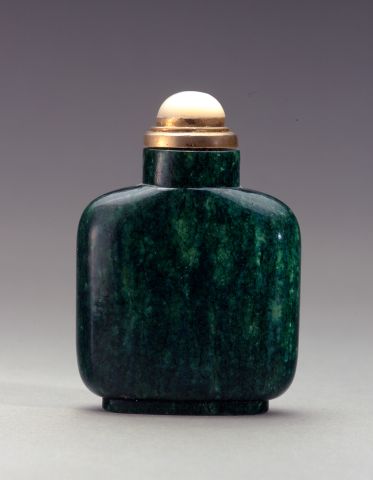
Bottle ID: 237
WALRUS, STAINED GREEN
Date: 1770-1820
Height: 56 mm
Walrus ivory, of flattened squared form with rounded shoulders, and a cylindrical neck, with a neatly carved oval footrim, stained a brilliant green in imitation of jadeite and of a smooth and waxy texture.
Similar Examples:
Lawrence, Clare. Miniature Masterpieces from the Middle Kingdom - The Monimar Collection of Chinese Snuff Bottles, 1996, pp. 50-51, no. 19.39.
Moss, Hugh, Victor Graham and Ka Bo Tsang. A Treasury of Chinese Snuff Bottles - The Mary and George Bloch Collection, 2009, Vol. 7, Part 1, pp. 234-235, no. 1559.
Hughes, Michael C. The Blair Bequest - Chinese Snuff Bottles from the Princeton University Art Museum, 2002, p. 103, no. 110.
Provenance:
Clare Lawrence Ltd.
Sotheby's, Arcade Sale, New York, June 14, 1994
Edith Griswold
Marine ivory bottles are at least as rare as those fashioned from elephant ivory and it is usually the walrus tusk that is used for fashioning snuff bottles in the Qing period. Very few of these bottles are carved, most are left with a plain surface although some have mock mask and ring handles which are almost always very well carved with fine detail. The majority of these walrus ivory bottles are stained with a brilliant emerald green color presumably in imitation of jadeite, although, unlike jadeite they acquire a soft patination with handling and are a joy to hold. If this is the case, jadeite appeared at the Court in the last quarter of the 18th century and walrus ivory bottles should therefore also be dated from around that period.
< Back to full list
 English
English 中文
中文